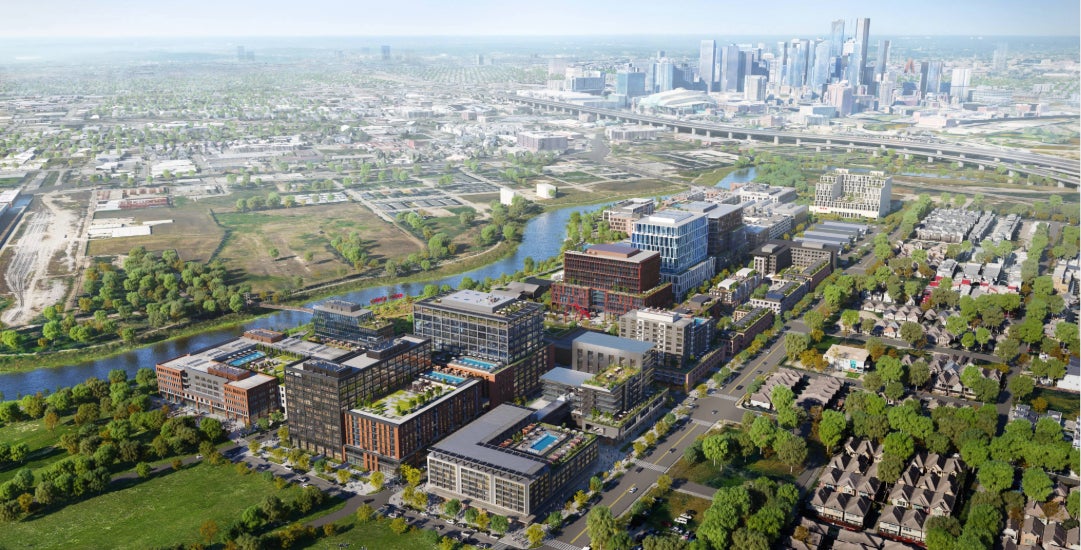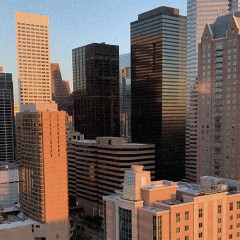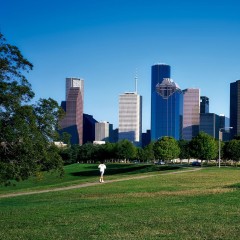The recently launched Texas chapter of the Council on Tall Buildings and Urban Habitat (CTBUH) will seek to make some of that report’s land-use preferences a reality, which would make Houston a denser and more walkable city.
CTBUH is an international nonprofit organization that explores how increased urban density and vertical growth can support more sustainable and healthy cities, considering concepts such as the social impact of tall buildings, the diversification of urban habitats, readaptation, livability and ecosystem retention.
Mide Akinsade, principal and design director at the Houston studio of Perkins&Will, is tasked with leading the new Texas chapter of the council. He and his colleagues were the master planners of East River, Phase II, Houston’s largest mixed-use development, located alongside Buffalo Bayou near downtown.
The Urban Edge spoke with Akinsade about the chapter’s mission and its ambitions to shape the future of Houston’s urban core. The interview has been edited for length and clarity.
How did you establish the Texas chapter of CTBUH?
I had been peripherally involved with CTBUH when I was working on the East Coast, before I moved to Houston. Once I relocated here, I wanted to get more actively involved. I saw the closest chapter was in Atlanta. It was going to be tough for me to attend those chapter meetings. Texas is big, Texas is very varied. I thought, “How come we don’t have a chapter in Texas?”
I contacted CTBUH Global, and said I was interested in starting a chapter in Houston. Some other people that are involved with CTBUH were also in Texas. Upon us having discussions together, we noticed some people lived in Austin, some people lived in Dallas and some people reside in Houston. We thought rather than trying to form one chapter per city, why don’t we just link arms to make it more potent, and have a Texas chapter that has those three cities under the umbrella? Each city is growing in different ways, each city has different issues when it comes to density and urbanism. We have also thought that San Antonio may be another city to pull under the umbrella in the future.
What are some of the challenges of implementing the council’s vision in Houston?
Given the way Houston has grown through time, the automobile has played a major role in how this city ended up forming. Of course, we’re sitting in the basket of oil and gas. It makes sense that oil subsidies with the automotive industry makes more roads, more cars and the city expands laterally. As part of city formation, the automobile has had the most impact in terms of urban sprawl. Unfortunately, it’s not sustainable because we’re creating all these impervious surfaces of roads. We have so many highways and the city is so vast.
What does it mean to meet Houston where it is right now? When the city starts expanding, how do we start infilling and making it densify to make sure the city feels a bit walkable? Right now, it’s almost completely nonwalkable, unless you’re in certain neighborhoods or pockets. One of the tenets of an ideal city is walkability — people can easily walk to work, walk to recreational activities or walk to retail.
With CTBUH, it’s not just about tall buildings, but looking for sustainable, vertical urbanism. We have vertical urbanism here in Houston, but how can we make it sustainable? One aspect is injecting a modicum of diversity into the land use. For example, in downtown with all these office buildings, it’s not ideal urban planning. In Houston, the uses aren’t varied. That explains why at 5 p.m., when everyone leaves their tall office buildings and goes home, it becomes a ghost town.
But part of sustainable, vertical urbanism is varying the program. Do these buildings have to be all office space? Can it be a mix of residential, which then brings retail? If people are living downtown they need somewhere to shop, they need somewhere to eat. That brings nightlife and walkability.
It’s that kind of attitude and overlaying it with sustainability. When you’re walking you want to walk in shaded streets. You want to have pocket parks. That’s what is at the root of what I’m trying to bring to Houston.
Alternatively, what are some advantages in Houston that align with the council’s vision?
Houston is a very unique city that doesn’t have any zoning. That creates the current context that we have. Obviously, it works, because it wouldn’t be the fourth-most populous city in the country if it didn’t. In my mind, Houston’s version of no zoning is actually its own version of zoning.
The first thing I said when I moved here was, “Wow, Houston has five bayous.” We know historically that any waterway is how most cities across the world developed — London, Paris and New York City are great examples. Houston started with the Buffalo Bayou with the Allen Brothers coming up the bayou, setting up camp at Allen’s Landing and then exploring and starting a city.
I wondered why Buffalo Bayou wasn’t more of an asset for the city, because it’s the genesis of this city. On top of that, we have four additional bayous. That’s 10 waterfronts that this city should be capitalizing on. Those should be the city’s playground. I understand the ebb and flow of the bayou and the amount of capital that might need to be invested.
With the Texas chapter of the council still in its infancy, what are some of your initial goals in the coming year?
Ideally, we want to have four events — one per quarter — and they will rotate around the council’s three Texas cities. For Houston, I would like to have a roundtable discussion with like-minded organizations. We could also invite panelists from across the city who can discuss how we densify the city — not just from a vertical standpoint, but from a sustainable urban standpoint which includes our bayous, bayou edges and other parts of the city.



